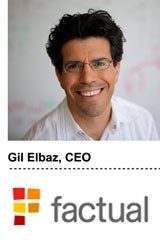 As mobile usage grows, so do demands for location-based ads. Helping advertisers optimize their location data has become a highly lucrative space, finds Gil Elbaz, founder of Applied Semantics (which turned into Google’s AdSense) and the startup Factual.
As mobile usage grows, so do demands for location-based ads. Helping advertisers optimize their location data has become a highly lucrative space, finds Gil Elbaz, founder of Applied Semantics (which turned into Google’s AdSense) and the startup Factual.
AdExchanger talked to Elbaz about the growth of location-based ads and Factual’s latest products, Geopulse Audience and Geopulse Proximity.
AdExchanger: When you last spoke with AdExchanger two years ago, Factual had recently launched. How has the company evolved since then?
GIL ELBAZ: What we were working on at the time was taking a variety of data sources and structuring and cleaning them in order to create a high-quality database for customers. At that time, our most popular database was around location. Since then, we’ve focused even more on location. We’ve taken it another level up in terms of the quality coverage and we’re building up our Global Places database.
Are you collecting data from mobile devices?
We’re not collecting any data from mobile devices. What we’re doing is working with partners who collect location data. There are many apps that collect location data based on permissions granted by the user. We are working with those companies that have collected user data by helping them process that data to get more out of the geo-location data that they store.
Who is in your target market?
Historically our target market has been developers and publishers that need location data to build their mobile location map. Our customers are Yelp, Foursquare, Bing—mostly large websites and mobile app developers. With this launch we’re expanding our target market to companies that didn’t realize they’re a location-based app or didn’t realize that they need location data.
What’s your business model?
Historically the bulk of our revenue came from subscription licenses to our data stream and the amount of the license would vary based on usage.
The new products will be somewhat similar in terms of being based on the number of users for which we’re developing profiles or enabling hyperlocal targeting capabilities through proximity.
Can you talk about your new Geopulse Audience tool and your partnership with MoPub?
MoPub is our launch partner for Geopulse Audience and what we’ll do is process the anonymized geolocation data [of MoPub’s clients] to build targeted user profiles. For example, say an anonymized user is a university student, a sports fan or an avid traveler. Those are 3 bucket examples that they may want to assign to a given user profile. In the case of MoPub, they could publish those bucket segments and allow advertisers to bid on that mobile ad inventory.
What about your partnership with Turn? What does that involve?
So Turn has a cloud marketing platform and their job is to help advertisers run targeted campaigns. They’re using Geopulse Proximity [a geofencing tool] to set up hyperlocal targets which will allow advertisers to select a subset of locations that could be based on categories or a certain name of a business like Starbucks and use it to enable ad campaigns. We can help a customer set up geofences based on a person’s proximity to the 65+ million places that we’ve established with our high data.
Let’s talk about funding. How much have you raised so far?
Our series A brought $25 million of new money. There was also a $2 million convertible note before that, so that brings the total to $27 million and that was all completed in December 2010.
Do you plan to take more?
We probably don’t need to this year or next, but given how exciting mobile is in terms of growth opportunities, we have a lot of ideas in terms of how we can enhance our products, so we’re starting to think about it.
How do consumer privacy concerns affect Factual’s business?
It doesn’t directly affect us since we’re not collecting information but nonetheless we’re making sure we can manage user privacy in an effective way. We’re working with partners who have the appropriate permissions to access user location data and the data isn’t sold or licensed to us. We also have a practice of regularly purging the data that our partners are giving out so that in the end, all we’re doing is processing it.
What’s on your roadmap?
Right now we’re happy with our suite of products. A download of 65+ million places or using all the data through an API is still a terrific opportunity for companies who don’t want to just show a bunch of points on a map but also do all sorts of internal analytics to enhance how they engage with people. We also have our Crosswalk for Places, which enables a simpler data integration with our services and other services like Foursquare, Facebook, Yelp—other location-based APIs that have their own merit. Especially with these new products, we want to tap into the much larger opportunity of helping a broader set of developers and publishers leverage location in new ways.












